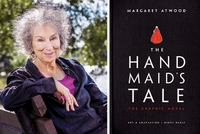The Year of the Flood
Margaret Atwood, . . Doubleday/Talese, $26 (434pp) ISBN 978-0-385-52877-1
In her 2002 speculative novel,
Like
The novel centers on the lives of Ren and Toby, female members of a fundamentalist sect of Christian environmentalists, the God's Gardeners. Led by the charismatic Adam One, whose sermons and eco-hymns punctuate the narrative, the God's Gardeners are preparing for life after the prophesied Waterless Flood. Atwood plays some of their religion for laughs: their hymns have a comically bouncing, churchy rhythm, and we learn that both Ren and Toby have been drawn toward the sect for nonreligious reasons. Yet the gentleness and benignity of the Gardeners is a source of hope as well as humor. As absurd as some of their beliefs appear, Atwood seems to be suggesting that they're a better option than the naked materialism of the corporations.
This is a gutsy and expansive novel, rich with ideas and conceits, but overall it's more optimistic than
Each novel can be enjoyed independently of the other, but what's perhaps most impressive is the degree of connection between them. Together, they form halves of a single epic. Characters intersect. Plots overlap. Even the tiniest details tessellate into an intricate whole. In the final pages, we catch up with Jimmy once more, as he waits to encounter the strangers. This time around, Atwood commits herself to a dramatic and hopeful denouement that's in keeping with this novel's spirit of redemption.
Reviewed on: 07/20/2009
Genre: Fiction
Compact Disc - 11 pages - 978-0-7393-8397-1
Downloadable Audio - 978-1-4159-6548-1
Hardcover - 434 pages - 978-0-7710-0844-3
Hardcover - 434 pages - 978-1-4088-0359-2
Hardcover - 434 pages - 978-0-7475-8516-9
Other - 448 pages - 978-0-307-39892-5
Other - 448 pages - 978-0-7710-0845-0
Paperback - 448 pages - 978-0-307-45547-5
Paperback - 595 pages - 978-0-7393-2850-7
Paperback - 448 pages - 978-0-307-39798-0
Paperback - 464 pages - 978-986-6385-12-4






